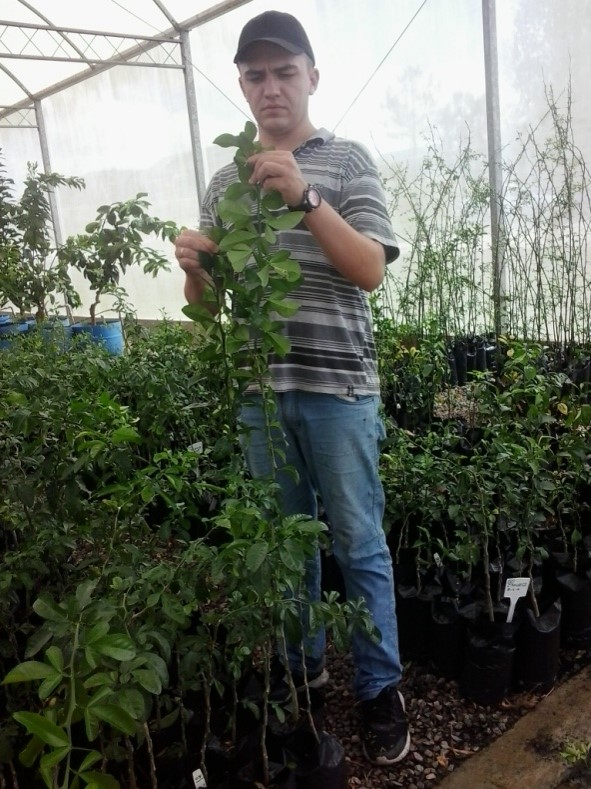Maria Luiza De Grandi, journalist from Ciência Rural, Santa Maria RS, Brazil.
Léo Omar Duarte Marques, post-graduate program in Agronomy, Universidade Federal de Pelotas (UFPel), 96160-000, Capão do Leão, RS, Brazil.
Brazil stands out in the production of sweet oranges (Citrus sinensis (L.) Osbeck), citriculture is one of the most important sectors of agribusiness in Brazil. As claimed by the Food and Agriculture Organization (2018), the annual production of these fruits represents about 35% from the whole national production. Rio Grande do Sul (RS) is the sixth largest producer in the country, with 352.451 tons per year (IBGE, 2020). The citriculture uses both the graft and the rootstock, the last one, due to phytosanitary problems, since it has a narrow base, is more susceptible to pests and diseases. (RODRIGUES et al., 2015)
In order to evaluate the 42 rootstocks behavior during the development of “Valência Late” orange tree seedlings in the nursery-phase, researchers from the Federal Univeristy of Pelotas (UFPel) in partnership with the Empresa Brasileira de Pesquisa Agropecuária and the Instituto Nacional de Investigación Agropecuária (INIA), elaborated the scientific paper Nursery performance of potentially promising rootstocks to Brazil’s south citriculture, published in Ciência Rural (vol. 52, n1).
In order to reach the results, the study was developed in a completely randomized cohort design, explains researcher Léo Omar Duart marques. “We kept track of the development of the rootstock during their nursery phase.” In the end of the study, grafting was performed; it consists of the junction of two different species, using the “Valência Late” technique, extensively used in the south of Brazil. The results points to possible alternatives of rootstock: “These alternatives will be tested A CAMPO, since our research focused on studying the initial growth of the rootstock, till its grafting”, highlights Marques.
The research brings important support to the citriculture in the South area of Brazil. “By offering new possible alternatives of rootstock, we expand the genetic base of rootstocks and this tends to lower the risk of diseases occurring that in the predominant genotype of the regions citriculture may be susceptible. ‘As an example, in the appearance of a disease where the trifoliata is susceptible and the “rough rind clover lemon tree” genotype presents tolerance or resistance, the grafted plants in this genotype would survive, or vice versa”, explains researcher Léo Marques.
The rootstock also influences the other characteristics such as the fruit’s flavor and productivity. “But, it’s important to consider that in the south region in Brazil, frosts are common to occurred, making it necessary an initial research on their adaptation, to minimize the risks of the citric belt inserting a new genotype of rootstocks, since many genotypes of citrus rootstocks can’t tolerate frosts.”, he completes.
According to the researcher, the paper opens doors to possible future research: “In our research we pointed out which rootstocks need special attention in new researches, we believe that we are forming and alicerce to further studies in addition to the previously studied rootstocks, which forth therefore we hope they will be used in large scale by the South’s of Brazil citriculture”, concludes.
References
FAO. Food and Agriculture Organization of the United Nations statistical database 2018, FAO.
IBGE Instituto Brasileiro de Geografia e Estatística. Levantamento sistemático da produção agrícola: pesquisa mensal de previsão e acompanhamento das safras agrícolas no ano civil. LSPA 2020, IBGE.
RODRIGUES, M. J. S. et al. Fruit characterization and propagation of hybrid citrus rootstocks in protected environment. Rev. Bras. Frutic. [online]. 2015, vol. 37, no. 2, pp.457-470 [viewed 25 July 2022]. https://doi.org/10.1590/0100-2945-068/14. Available from: https://www.scielo.br/j/rbf/a/c8VRVmvKfW85gY5bfQbBNgz/?lang=pt
RODRIGUES, M.J.S., et al. Citrus nursery tree production using different scion and rootstock combinations in screen house. Rev. Bras. Frutic. [online]. 2016, vol. 38, no. 1, pp.187-201 [viewed 25 July 2022]. https://doi.org/10.1590/0100-2945-284/14. Available from: https://www.scielo.br/j/rbf/a/nVJ3vdjLjvqgtkKMXbhPCdN/?lang=pt
To read the article, access
MARQUES, L.O.D., et al. Nursery performance of potentially promising rootstocks for citriculture in the south of Brazil. Cienc. Rural [online]. 2022, vol. 52, no. 1, e20200227 [viewed 25 July 2022]. https://doi.org/10.1590/0103-8478cr20200227. Available from: https://www.scielo.br/j/cr/a/PxdBgPhWNMML63vTKWH8LKK/?lang=en
External links
Ciência Rural – Social media: Twitter | Instagram | Facebook
Ciência Rural: http://coral.ufsm.br/ccr/cienciarural/
Ciência Rural – CR: https://www.scielo.br/j/cr/
Como citar este post [ISO 690/2010]:
















Recent Comments